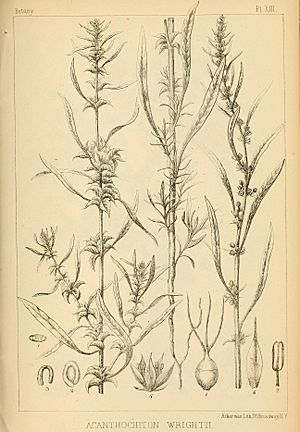Greenstripe facts for kids
Quick facts for kids Greenstripe |
|
|---|---|
 |
|
| Scientific classification | |
| Genus: |
Amaranthus
|
| Species: |
acanthochiton
|
The greenstripe (scientific name: Amaranthus acanthochiton) is a type of plant that lives for only one year. It belongs to the Amaranthus family, which includes many well-known plants. This plant is special because it grows in dry areas of the United States and Mexico.
Contents
About the Greenstripe Plant
The greenstripe plant is not very common. It prefers to grow in places that are between 1,000 and 2,000 meters high. This means it likes areas that are a bit elevated, like hillsides or plateaus.
What it Looks Like
The greenstripe plant can grow to be anywhere from 10 to 80 centimeters tall. That's about the height of a small ruler to almost a meter!
- Leaves: Its leaves are thin and long. They can be 2 to 8 centimeters long and 2 to 12 millimeters wide.
- Flowers: The flowers are a pale green color. They grow in tight bunches at the very top of the plant, almost like a spike.
- Seeds: The seeds are small and brown, about 1 to 1.3 millimeters wide. They are held inside a tiny case called an achene, which is about 2 to 2.5 millimeters wide.
Special Features
One interesting thing about the greenstripe is that it is a dioecious plant. This means that individual plants are either male or female. The male plants produce pollen, and the female plants produce seeds. You need both a male and a female plant nearby for seeds to be made.
Protecting the Greenstripe
Sadly, the greenstripe plant is in danger. In the state of Utah, it is considered critically endangered. This means there are very few of these plants left in the wild there. In Arizona, it is also considered endangered, though its official status is still being decided. Efforts are being made to protect this unique plant so it doesn't disappear.
Its Uses
Long ago, the Hopi Indians, a Native American tribe, used the greenstripe plant as a food source. They knew how to use the plant's parts in different ways:
- Seeds: The seeds were cooked and eaten like a type of porridge.
- Leaves: The young leaves were used as greens, similar to how we might eat spinach or kale today.
See also
 In Spanish: Amaranthus acanthochiton para niños
In Spanish: Amaranthus acanthochiton para niños

